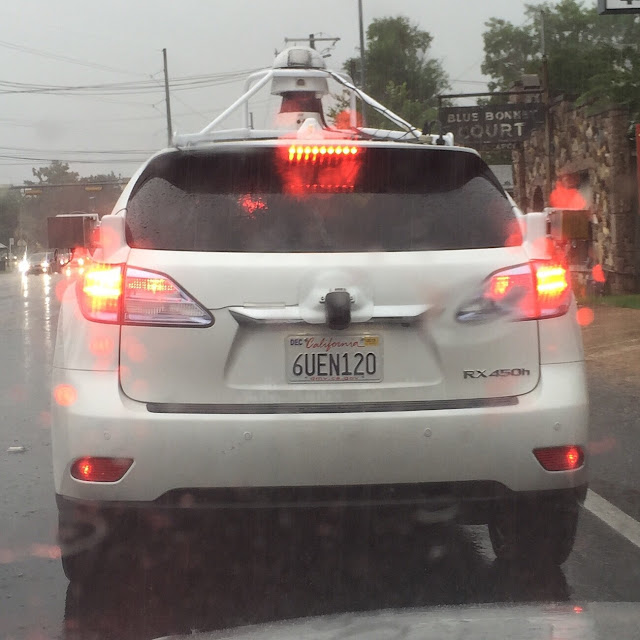Two weeks and three days after it released details of its self-driving car project for the month of June,in which it shared that its self-driven Lexus SUVs were involved in two minor accidents, Google has once again announced that one its Lexus RX450h driverless cars got into an accident on July 1, which caused three Google employees to suffer from minor whiplash. Here's what the director of shared in a blog post. Mr. Urmson says Google cars were not to blame for the accident but human drivers who keep running into them.Have it in mind that this recent accident takes the number to 15;not 14 as was reported in the article.
Chris Urmson.
Summer is one of the most dangerous times of the year on U.S. streets, as many of us spend more time behind the wheel, heading out for long road trips or local barbecues. The AAA Foundation for Traffic Safety, for example, has declared the period between Memorial Day and Labor Day to be “The 100 Deadliest Days” for teenage drivers — and they’re not on the roads alone. Statistics like this keep my team and me working hard on a fully self-driving car that can get you from A to B safely, no matter how many beverages you have by the pool or how many texts you send to the new friend you met there.
Our self-driving cars are being hit surprisingly often by other drivers who are distracted and not paying attention to the road. That’s a big motivator for us. The most recent collision, during the evening rush hour on July 1, is a perfect example. One of our Lexus vehicles was driving autonomously towards an intersection in Mountain View, CA. The light was green, but traffic was backed up on the far side, so three cars, including ours, braked and came to a stop so as not to get stuck in the middle of the intersection. After we’d stopped, a car slammed into the back of us at 17 mph — and it hadn’t braked at all.
As you can see from the video above, our braking was normal and natural, and the vehicle behind us had plenty of stopping distance — but it never decelerated. This certainly seems like the driver was distracted and not watching the road ahead. Thankfully, everyone in both vehicles was okay, except for a bit of minor whiplash, and a few scrapes on our bumper. The other vehicle wasn’t so lucky; its entire front bumper fell off.
Although we don’t like getting hit, there’s a silver lining here. We all want to know how self-driving cars are measuring up against their human counterparts, but the statistics we need to do this simply aren’t ordinarily gathered. National crashes-per-miles-driven rates are currently calculated on police-reported crashes. Yet there are millions of fender benders every year that go unreported and uncounted — potentially as many as 55% of all crashes, according to the National Highway Traffic Safety Administration. (None of the accidents in which people hit us resulted in a police report — not even the July 1 crash, even though the police were on site.) Furthermore, the numbers that are available don’t distinguish between miles-driven before causing a crash vs simply being involved in one. This all means no one knows the real crashes-per-miles-driven rates for typical American streets.
But we’re now driving enough — and getting hit enough — that we can start to make some assumptions about that real crashes-per-miles-driven rate; it’s looking higher than we thought. (Our cars, with safety drivers aboard, are now self-driving about 10,000 miles per week, which is about what a typical American adult drives in a year.) It’s particularly telling that we’re getting hit more often now that the majority of our driving is on surface streets rather than freeways; this is exactly where you’d expect a lot of minor, usually-unreported collisions to happen. Other drivers have hit us 14 times since the start of our project in 2009 (including 11 rear-enders), and not once has the self-driving car been the cause of the collision. Instead, the clear theme is human error and inattention. We’ll take all this as a signal that we’re starting to compare favorably with human drivers.
Our self-driving cars can pay attention to hundreds of objects at once, 360 degrees in all directions, and they never get tired, irritable or distracted. People, on the other hand, “drive as if the world is a television show viewed on TiVo that can be paused in real time — one can duck out for a moment, grab a beer from the fridge, and come back to right where they left off without missing a beat” — to quote Sheila Klauer of the Virginia Tech Transportation Institute in Traffic: Why We Drive the Way We Do. That’s certainly consistent with what we’re seeing. Please, as you get behind the wheel this summer, keep your eyes on the road. The fight to end distracted driving starts with each of us — at least until that day when you can summon a self-driving car and just kick back, relax, and enjoy the ride.
Source: Chris Urmson, Medium
